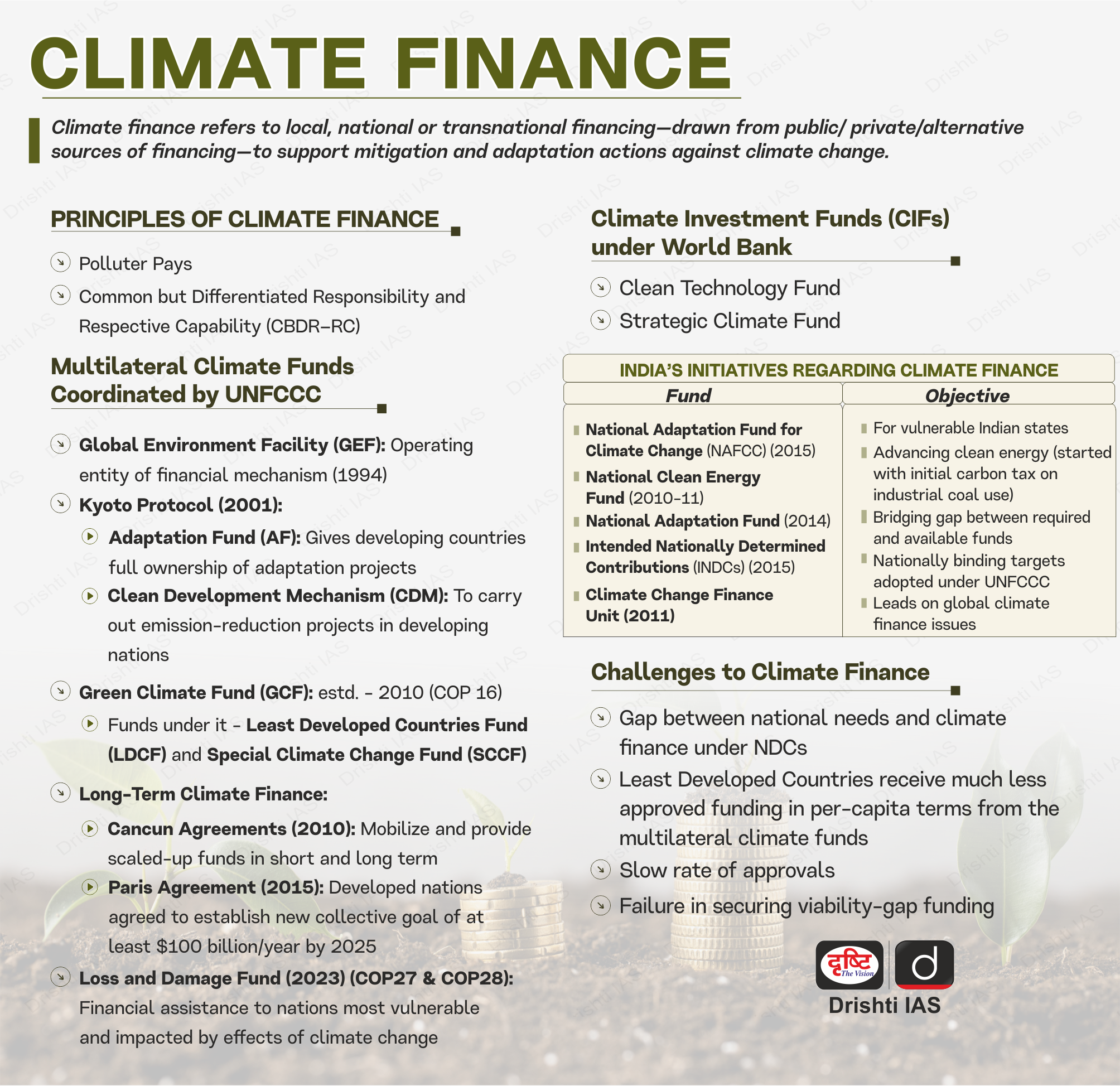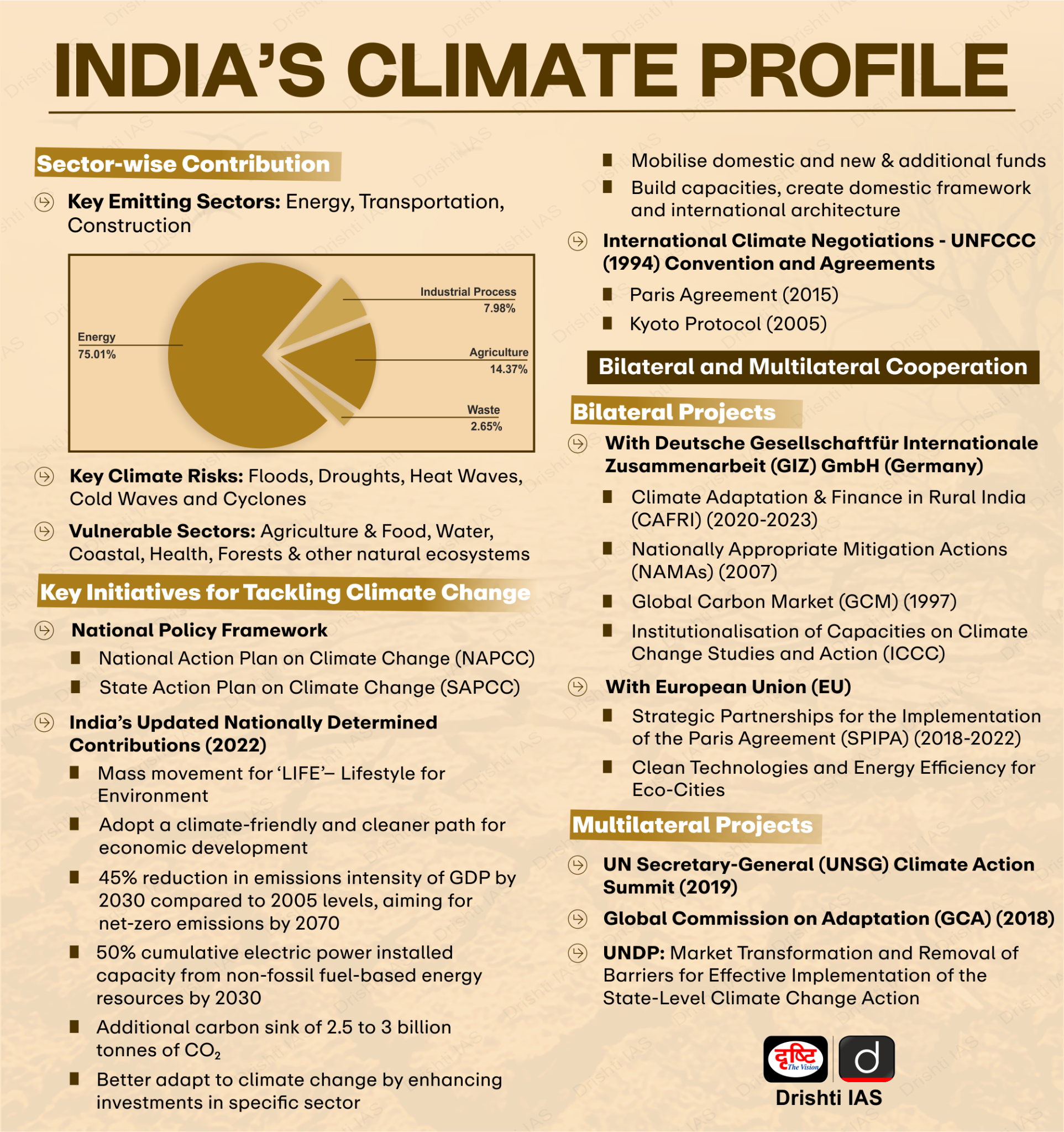Biodiversity & Environment
Paris Agreement Climate Finance Target for 2022
- 31 May 2024
- 6 min read
For Prelims: Organisation for Economic Cooperation and Development, Climate Finance Goal, World Bank, Multilateral Development Banks, New Collective Quantified Goal
For Mains: Climate finance to developing countries, Effectiveness of international climate finance mechanisms, Economic Development and Environmental Sustainability
Why in News?
The Organisation for Economic Cooperation and Development (OECD) released a report stating that developed countries provided and mobilised more than USD 100 billion in climate finance to developing countries in 2022, after failing to do so in previous years.
What are the Key Highlights of the OECD Report?
- Climate Finance Goal: Developed countries provided and mobilised USD 115.9 billion in climate finance to developing countries in 2022. This achievement comes two years later than the original 2020 target year.
- Dominance of Public Climate Finance: Public climate finance from bilateral (countries) and multilateral sources (like the World Bank) accounted for close to 80% of the total financial flow in 2022. Nearly 90% of financing from Multilateral Development Banks (MDBs) was in the form of loans.
- Bilateral sources provided USD 41 billion, while multilateral sources provided USD 50.6 billion. Mobilised private finance accounted for USD 21.9 billion in 2022.
- Nature of Financial Instruments: Loans constituted 70% of public climate finance, raising concerns about debt burdens on developing countries. Grants made up only 28% of the total public climate finance.
- Distribution by Income Level: Lower-income countries received 64% of their public climate finance as grants, whereas lower-middle-income countries received only 13% as grants.
- Funding for Mitigation vs Adaptation: Most of the finance went towards mitigation efforts, with adaptation activities receiving USD 32.4 billion in 2022.
- Expert Concerns and Recommendations: Experts called for more transparent accounting and a clear definition of climate finance.
- Critics argue that the heavy reliance on loans undermines climate justice principles.
- The USD 100 billion target is deemed inadequate compared to the estimated USD 1 trillion needed annually by 2030 for developing nations to effectively combat climate change.
What is the Future of Climate Finance Goal?
- Negotiations are underway to establish a new, more ambitious New Collective Quantified Goal (NCQG) on climate finance. This is expected to be adopted at COP29 summit in Baku, Azerbaijan, in November 2024.
- Under NCQG developed countries must meet from 2025 onward to provide climate finance to developing countries and it will supersede the 2015 Paris Agreement.
- A 2021 report by UN Climate Change estimated that developing countries would need about USD 6 trillion annually until 2030 to implement their climate action plans.
- India has urged developed countries to provide at least USD 1 trillion per year in climate finance to developing countries from 2025 to address global warming.
Organisation for Economic Co-operation and Development
- The OECD is an international organisation of 38 democratic countries committed to the market economy.
- It was established in 1960, by 18 European nations, the United States, and Canada, with headquarters in Paris, France.
- The OECD aims to shape policies that foster prosperity, equality, opportunity, and well-being for all, and publishes economic reports, statistical databases, analyses, and forecasts on global economic growth.
- It also works to eliminate bribery and financial crime worldwide and maintains a "black list" of uncooperative tax havens.
- Additionally, the OECD has working relationships with non-member economies like India, in addition to its member countries.
|
Drishti Mains Question: Q. Discuss the extent to which the world is on track to meet the goals set by the Paris Agreement to contain global warming and mitigate issues arising from climate change. |
Read more: Climate Finance Road to COP29, India’s Climate Profile (Part - II)
UPSC Civil Services Examination Previous Year Question (PYQ)
Prelims:
Q. With reference to the Agreement at the UNFCCC Meeting in Paris in 2015, which of the following statements is/are correct? (2016)
- The Agreement was signed by all the member countries of the UN, and it will go into effect in 2017.
- The Agreement aims to limit the greenhouse gas emissions so that the rise in average global temperature by the end of this century does not exceed 2ºC or even 1.5ºC above pre-industrial levels.
- Developed countries acknowledged their historical responsibility in global warming and committed to donate $ 1000 billion a year from 2020 to help developing countries to cope with climate change.
Select the correct answer using the code given below:
(a) 1 and 3 only
(b) 2 only
(c) 2 and 3 only
(d) 1, 2 and 3
Ans: B
Mains:
Q. Describe the major outcomes of the 26th session of the Conference of the Parties (COP) to the United Nations Framework Convention on Climate Change (UNFCCC). What are the commitments made by India in this conference? (2021)
Q. Explain the purpose of the Green Grid Initiative launched at the World Leaders Summit of the COP26 UN Climate Change Conference in Glasgow in November 2021. When was this idea first floated in the International Solar Alliance (ISA)? (2021)








